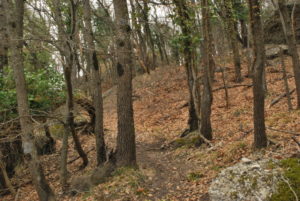General description of project area
Name of the project area: Monte Mauro
Surface area (ha): 275.060
EU protection status SPA: NATURA 2000 Code 30001
EU protection status SCI: NATURA 2000 Code IT4070011
Other protection status according to national or regional legislation: Natural Regional Park
The main uses of the project site: The main land uses: Nature Conservation 90%, forestry 5%, agriculture 5%
The ownership status: State property 90%; Public property: 10%

Scientific description of project area
The site contains the most important and wild sector of the outcrop of Messinian gypsum in Europe, an area of great geological and naturalistic interest. The layers of the so-called Gypsum Vein, inclined towards the plain, cause precipitous cliffs facing south (here one of the higher and wider) and with interesting Mediterranean character (Pistacia terebinthus, Rhamnus alaternus, Juniperus oxycedrus, Helianthemum appenninum, Fumana procumbens), contrasting with the more moderate slopes facing north, wooded, with fresh stations and rich in floristic elements typical of the high Apennines (Phyllitis scolopendrium, Galanthus nivalis, Tilia xvulgaris, Mercurialis annua, Corydalis cava, Laburnum anagyroides, Staphylea pinnata).
The whole area is characterized by widespread karst phenomena on the surface (blind valleys, sinkholes, ravines, erosive forms, plowed fields) and on the underground (sinkholes, resurgent, chasms and caves also of considerable development), which contribute to diversify peculiar morphologies, rich in contrasts and environments with high biodiversity. The site has a very diverse flora with Mediterranean and Central European elements, as well as an interesting aboveground and underground fauna. Woods and thickets mesophilic and xerophilous dominated by Quercus pubescens (91AA*), with slopes stations of Quercus ilex (9340), moist ravines with mesophilic flora, alternating with shrubs and grasslands, ex-cultivated land, scrubland and rocks colonized by ferns and therophytes, wide xeric meadows with orchids (6210*), in natural evolution to the Q. pubescens forests (91AA*). The caves have a well-preserved natural environment, with an abundance of ferns and specialized flora, colonies of bats and troglophile and troglobitic invertebrate fauna. Agricultural crops are relatively uncommon in the area, more common on the surrounding area. The area is inside the regional park Vena del Gesso Romagnola.
Fifteen habitats are protected by the annex I of the 92/43/EEC directive:
3150-Natural eutrophic lakes with vegetation of Magnopotamion or Hydrocharition
5130-Juniperus communis formations on heaths or calcareous grasslands
5210-Arborescent matorral with Juniperus spp.
6110*-Rupicolous calcareous or basophilic grasslands of the Alysso-Sedion albi
6210*-Semi-natural dry grasslands and scrubland facies on calcareous substrates (Festuco-Brometalia) with important orchid sites (64,19 ha)
6220*-Sub-steppe with grasses and annuals of the Thero-Brachypodietea
6510 – Hay meadows lean or low-altitude
7220*-Petrifying springs with tufa formation (Cratoneurion)
8210-Calcareous rocky slopes with chasmophytic vegetation
8310-Caves not-for tourism (220 caves)
9180*-Forests of slopes and screes of the Tilio-Acerion
91AA*-Eastern white oak forests (92,63 ha)
9260-Woods of Castanea sativa
92A0-Gallery forests of Salix alba and Populus alba
9340-Forests of Quercus ilex and Quercus rotundifolia
One species of plant protected by the annex II of the 92/43/EEC directive: Himantoglossum adriaticum.
A rich flora in Orchids and Pteridophytes (22 species, including the unique in Italy and western Europe population of Cheilanthes persica).
Birds of the annex I of the 09/147/EU directive:
Pernis apivorus (B), Milvus migrans, Circaetus gallicus (B), Circus aeruginosus, Circus cyaneus, Circus pygargus (B), Pandion haliaetus, Falco vespertinus, Falco columbarius, Falco peregrinus (B), Crex crex, Bubo bubo (B), Caprimulgus europaeus (B), Coracias garrulus, Calandrella brachydactyla, Lullula arborea (B), Anthus campestris (B), Lanius collurio (B), Emberiza hortulana (B)
Mammals of the annex II of the 92/43/EEC directive:
Rhinolophus hipposideros, Rhinolophus ferrumequinum, Rhinolophus euryale, Barbastella barbasyellus, Myotis blythii, Miniopterus schreibersii, Myotis emarginatus, Myotis bechsteinii, Myotis myotis, Canis lupus*, Amphibians and Reptiles of the annex II of the 92/43/EEC directive, Triturus carnifex, Bombina pachypus, Emys orbicularis, Invertebrates of the annex II of the 92/43/EEC directive, Callimorpha quadripunctaria *, Osmoderma eremita *, Lucanus cervus, Cerambyx cerdo, Vertigo angustior.
Importance of the project area for biodiversity and/or for the conservation of the species /habitat types targeted at regional, national and EU level
The biogeographic significance of the Monte Mauro is linked to its really high biodiversity, its Mediterranean flora, with many elements at the northern limit in the Apennines. Among these, the 91AA* Eastern white oak forests (92,63 ha) are here present as submediterranean forest formations with Quercus pubescens and Fraxinus ornus, Ostrya carpinifolia, Carpinus orientalis, Sorbus domestica, Spartium junceum, Scabiosa columbaria, Silene nutans, Coronilla emerus, Anthericum ramosum, Dictamnus albus, Geranium sanguineum, Epipactis helleborine, Rubia peregrina, Osyris alba, Dorychnium hirsutum, Peucedanum cervaria and stenomediterranean species such as Asparagus acutifolius, Rubia peregrina, Clematis flammula, Rosa sempervirens, Juniperus oxycedrus. The xeric meadows with Bromus erectus and many species of orchids (6210*) are covering 64,19 ha and are strictly linked to the habitat 91AA*. The structure of these forests is often modified and simplified by the widespread past coppice activity in private forests, now abandoned and also forbidden in the park, in which only the tall forest conversion is allowed; the privates are not interested in the conversion and the forests are abandoned or illegally coppiced, so it is very important to purchase these forests to manage the conversion and to stop illegal coppicing. Other serious threats are the fires and the uncontrolled cleaning of the forest, by cutting undergrowth and new plants; presence of invasive nonnative species Ailanthus altissima and Robinia pseudoacacia; wide presence of old re-forestation with non-native species Pinus nigra, Pinus sylvestris, Juglans nigra (all the wide forests areas includes in the project area and not classified as 91AA* could be this priority habitat if it wasn’t for the high presence of exotic pines); high agriculture pressure along the borders of forests.
Flagship species in project area
Delphinium fissum, Bubo bubo, Rhinolophus euryale